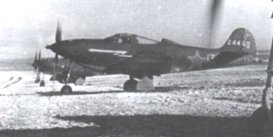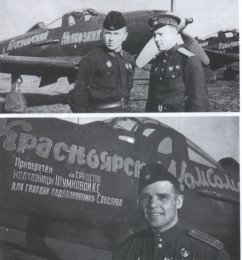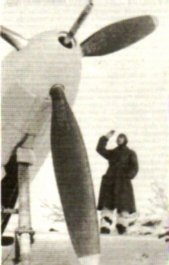| |
|||||
| This article has been updated with new research. The original text will be left "as-is". This helps to track the progress of newer and better information, discoveries, and thoughts about VVS camouflage. Also it is fascinating to see how, or if, perceptions evolve. The updated text will appear in a box like this, and this should be seen when in contradiction to the original to be the correct current interpretation, supplanting the former. |
P-39L-1 "White 13"
|

 |
This attractive Airacobra was photographed in the Kuban region in 1943. The
lightning bolt motif seems to have been applied to many of the aircraft in this
eskadrilya of the 100th Guard's Regiment, and thus does not appear to
be a personal marking. The US applied serial number (s/n 24480) is present and
quite clear, though the rudder shows various discoloration (perhaps due to wear).
The spinner is quite dark and looks to be black, while the national star marking
on the fuselage sports a yellow border. The camouflage appears to be the US
O.D. over Grey scheme, and a small circle of AMT-4 green appears on the fuselage,
probably covering the white disc applied in Buffalo.
| A slightly better photo of this aircraft has been seen since the original artwork, and now I have amended my interpretation slightly. The entire aircraft looks dark to me, and so I have drawn the O.D. colour with a quite 'aged' appearance. The spinner is possibly the same colour. The rudder looks like a replacement to me, and then one is forced to consider that the machine's serial number is in fact not "244 80", but rather "244..??". The lack of any re-finishing evidence around the fuselage might simply be a case of A-24m Green being used against the dark O.D.; one would never spot it in a photo of this low quality. |
P-39Q(?) "White 119"
|
 |
"119" is described as a P-39Q in the photograph caption, but this does not seem to match the visible first three numbers of the US serial number (s/n 243--). There are no wing guns present on the aircraft and a 37mm gun through the spinner, but aside from those clues I'm afraid that I do not know the various Airacobra variants well enough to distinguish what model it might be.
The rudder of "White 119" appears to have been painted with white color somewhat thinly, much of the underlying color showing through, and features a plain red star. The US camouflage was retained, but a large 'blob' of AMT-4 green is obvious on the fuselage beneath the national Victory type star marking. The spinner seems to have been polished metal color. The inscription on the nose reads, " Rebenok Kieva " ("Child of Kiev"), and is preceded by an Order of Lenin emblem. Interestingly, though the pilot of "119" is not known, it is also true that Lt. Skulski of the 196 IAP was a native of Kiev, and the inscription might well apply to him.
The only known photograph of "White 119" resides in the personal collection
of Dmitri Volonin and is not available for publication.
P-39D/P-400 "Red 60", "Red 79", "Red 95"
|


 |

The color of these aircraft is a matter of debate. The most consistent explanation is that they are 'silver' in color due to the shade and high surface light reflectivity, and for now the evidence supports this interpretation. Therefore, one wonders as well if the machines were repainted entirely in AII Aluminum lacquer, or if they were stripped of all paint? Given the smaller work-load in so doing, and the similarity of appearance between the rudder and fuselage (noting that the fabric covered rudder must have been painted), I believe that overprinting with AII(AL) lacquer is by far more likely.
Most of the markings were executed in red. Carl-Fredrik Geust, in his usually outstanding way, has now produced a better version of this photo in Red Stars 4 which allows for an improved investigation of the foremost Airacobra. Number "95", foreground, is the exception, and the color of its numerals is a complete mystery. It may be that they are primarily white (or a similar color), but with a significant red trim. As well, this aircraft shows a dark colored air intake scoop assembly, and this might be painted with A-24m green (as shown). The star on the fin/rudder is not symmetrical, and it seems that the rudder might be a replacement. Moreover, some considerable wear is now evident on the fuselage, and this seems to demonstrate underlying areas of Olive Drab and Neutral Grey. If true, this would confirm that these machines were indeed painted with AII Aluminum.
Furthermore, it seems that on "95" the outer wing upper surface might, in fact, be exposed Olive drab color. And, looking at the bottom of the wing root fairing, I have my doubts if the wing undersurface has been painted, as well. The improved view of "95" has provided more questions, it seems, than answers!
Number "60", second, features overly thick numerals, and the fuselage star
on "Red 79" appears to be crooked. All of these markings were probably hand
painted, which explains their dissimilarity.
| By now I am pretty certain that these machines are wearing AII Aluminum lacquer over the upper surfaces. The lower surfaces look to still be the original US Neutral Grey colour. As well, the outer third of the port wing of "95" looks to be in its original OD colouration, as is the air intake fairing. Once again, the Navy showing their preference for quite bizarre camouflage.... |
P-39N "White 61"
|
 |
Stroikov's Airacobra "61" was photographed in the Kursk region during the summer of 1943 when he was a young and unknown Mld. Letenant. The photograph caption identifies the aircraft as an 'N' model, and I do not know if this is correct; no guns are visible in the wings.
"White 61" retained its US applied camouflage, but the rear fuselage and fin/rudder were heavily overpainted with AMT-4 green. The spinner was finished in red, and there was a very attractive red flash on the fin and rudder trimmed with a thin white band. A small numeral "23" (thought to be in red) was present on the rudder; its meaning is unknown. The forward fuselage sports a large white band, and it is not currently known if this was a personal or unit marking.
The most unusual feature on "61" is the discoloration on the aircraft's port
door, and due to the large amount of light reflecting off of its surface this
is thought to be bare metal. It would seem that this machine sported some artwork
or other feature on the door that was not acceptable to Stroikov when he acquired
this aircraft in May 1943, and it looks as though whatever was present was removed
with turpentine.
P-39N(?) "Krasnoyarskiy Komsomolets"
|

 |

The inscription "Krasnoyarskiy Komsomolets" is present on both fuselage sides, but is not symmetrical, and clearly executed by hand. The text color is thought to be red, and is trimmed very thinly in white. Guards emblems are present on both fuselage sides, as are white bordered national markings. The spinner appears to be white, but much of the underlying black color seems to be showing through along the tip.
Guns are present in the wings, but again I am not certain if these are really
'N' model P-39s. One further difficulty is that there are a series of photographs
showing these aircraft both fore and aft, but none of them show together the
forward and rearward view. Thus, one is left to 'count down the line' and match
up "tails to noses". I think that I have these matched up correctly, but other
photos may later materialize and prove me wrong (as happens all-too-often in
VVS matters).
P-39N(?) "Krasnoyarskiy Rabochiy"
|
 |
P-39 "Krasnoyarskiy Rabochiy" ("Krasnoyarsk Worker") once again retained its US applied camouflage, but also has been heavily repainted with AMT-4 green color. The view to port is better on another photograph, and I have chosen to draw that side only (though much can be seen to starboard in the photo above).
The rudder appears to be US O.D., as supplied, and retains two digits of the
original serial number (s/n ---03). The inscription "Krasnoyarskiy Rabochiy"
looks to have been applied in white, and there is no smaller dedication
text on the starboard nose. The spinner appears to have been painted with AMT-4.
No information is available on the wing undersurfaces.
P-400 "Red 77"
|
 |
White colored P-39s are rare in VVS service, and this ex-RAF P-400 is surely one of the most attractive. "77" was photographed in service with the 6th Independent Fighter Eskadrilya on the Northern Front, winter of 1942-43. The pilot has been identified by two different authors as Yuri Penakov, presumably by appearance (the photo features no caption).
"Red 77" is very smartly finished in white MK-7 distemper, but the underside US applied Neutral Grey seems to remain. The rudder seems to show the underlying color through the white appliqué, however, giving a worn appearance. The national star marking is trimmed in yellow, giving a very nice appearance on the white background.
Alas, just before writing this article it occurred to me that I do not have permission to publish the port side photo of "Red 77", and so for the time being this anemic view from the nose will have to suffice. It does, though, offer a clue as to the professionally applied white color, and shows the pilot standing behind.
